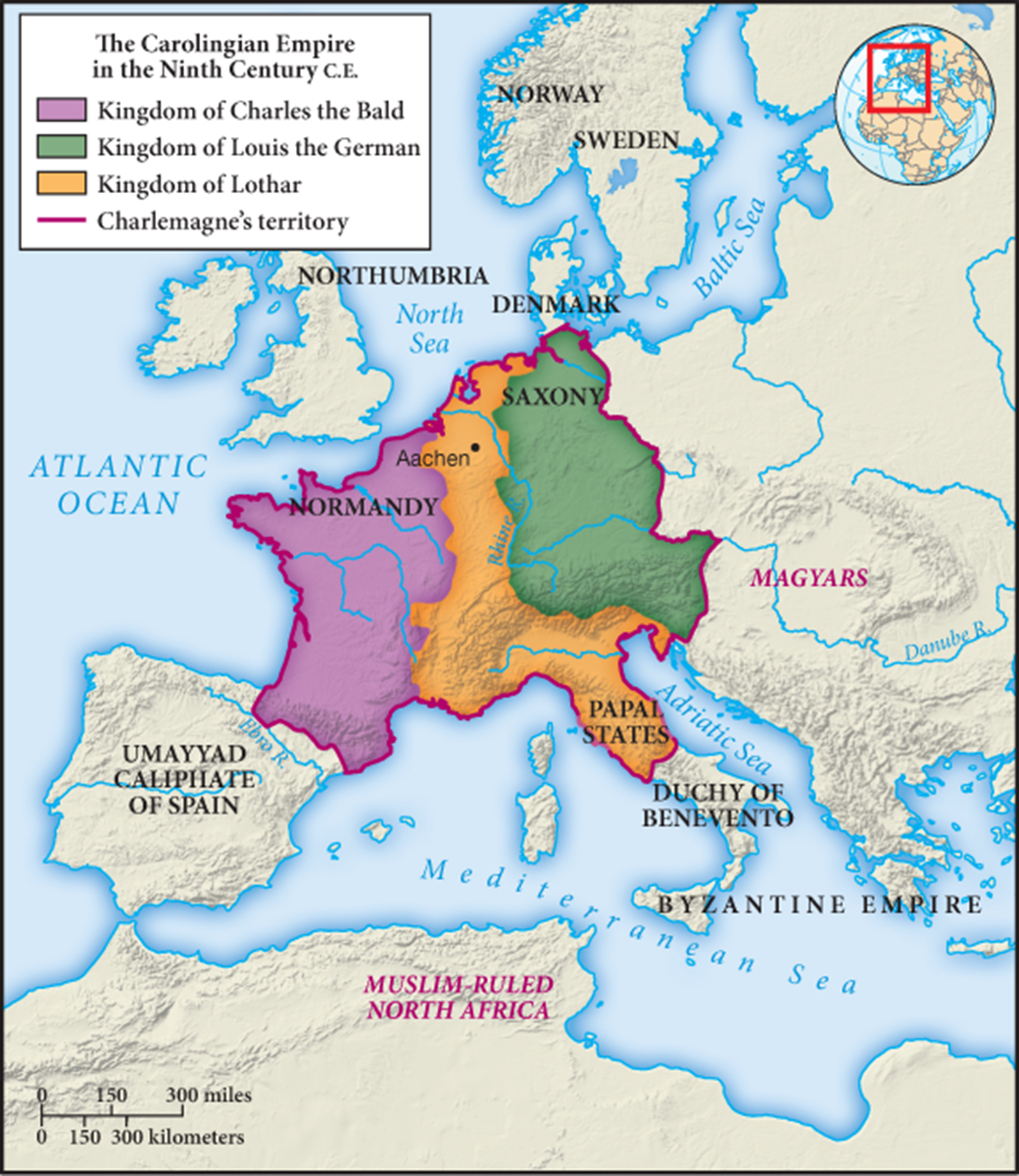Political Life in Western Europe
In the early centuries of this era, history must have seemed more significant than geography, for the Roman Empire, long a fixture of the western Mediterranean region, was gone. The traditional date marking the collapse of the empire is 476, when the German general Odoacer overthrew the last Roman emperor in the West. In itself not very important, this event has come to symbolize a major turning point in the West, for much that had characterized Roman civilization also weakened, declined, or disappeared in the several centuries before and after 476. Any semblance of large-scale centralized rule vanished. Disease and warfare reduced Western Europe’s population by more than 25 percent. Land under cultivation contracted, while forests, marshland, and wasteland expanded. Urban life too diminished sharply, as Europe reverted to a largely rural existence. Rome at its height was a city of 1 million people, but by the tenth century it numbered perhaps 10,000. Public buildings crumbled from lack of care. Outside Italy, long-distance trade dried up as Roman roads deteriorated, and money exchange gave way to barter in many places. Literacy lost ground as well. Germanic peoples, whom the Romans had viewed as barbarians—Goths, Visigoths, Franks, Lombards, Angles, Saxons—now emerged as the dominant peoples of Western Europe. In the process, Europe’s center of gravity moved away from the Mediterranean toward the north and west.
What replaced the Roman order in Western Europe?
Yet much that was classical or Roman persisted, even as a new order emerged in Europe. On the political front, a series of regional kingdoms—led by Visigoths in Spain, Franks in France, Lombards in Italy, and Angles and Saxons in England—arose to replace Roman authority. But many of these Germanic peoples, originally organized in small kinship-based tribes with strong warrior values, had already been substantially Romanized. Contact with the Roman Empire in the first several centuries C.E. had generated more distinct ethnic identities among them, militarized their societies, and given greater prominence to Woden, their god of war. As Germanic peoples migrated into or invaded Roman lands, many were deeply influenced by Roman culture, especially if they served in the Roman army. On the funeral monument of one such person was a telling inscription: “I am a Frank by nationality, but a Roman soldier under arms.”13
The prestige of things Roman remained high, even after the empire itself had collapsed. Now as leaders of their own kingdoms, the Germanic rulers actively embraced written Roman law, using fines and penalties to provide order and justice in their new states in place of feuds and vendettas. One Visigoth ruler named Athaulf (r. 410–415), who had married a Roman noblewoman, gave voice to the continuing attraction of Roman culture and its empire:

Map 10.2 Western Europe in the Ninth Century Charlemagne’s Carolingian Empire brought a temporary political unity to parts of Western Europe, but it was subsequently divided among his three sons, who waged war on one another.
At first I wanted to erase the Roman name and convert all Roman territory into a Gothic empire…. But long experience has taught me that … without law a state is not a state. Therefore I have more prudently chosen the different glory of reviving the Roman name with Gothic vigour, and I hope to be acknowledged by posterity as the initiator of a Roman restoration.14
Several of the larger, though relatively short-lived, Germanic kingdoms also had aspirations to re-create something of the unity of the Roman Empire. Charlemagne (SHAHR-leh-mane) (r. 768–814), ruler of the Carolingian Empire, occupying what is now France, Belgium, the Netherlands, and parts of Germany and Italy, erected an embryonic imperial bureaucracy, standardized weights and measures, and began to act like an imperial ruler. On Christmas Day of the year 800, he was crowned as a new Roman emperor by the pope, although his realm splintered shortly after his death (see Map 10.2). Later Otto I of Saxony (r. 936–973) gathered much of Germany under his control, saw himself as renewing Roman rule, and was likewise invested with the title of emperor by the pope. Otto’s realm, subsequently known as the Holy Roman Empire, was largely limited to Germany and soon proved little more than a collection of quarreling principalities. Though unsuccessful in reviving anything approaching Roman imperial authority, these efforts testify to the continuing appeal of the classical world, even as a new political system of rival kingdoms blended Roman and Germanic elements.
